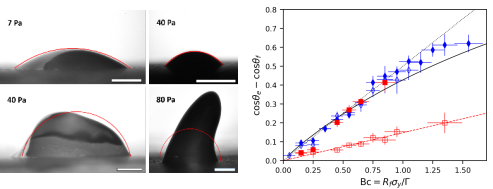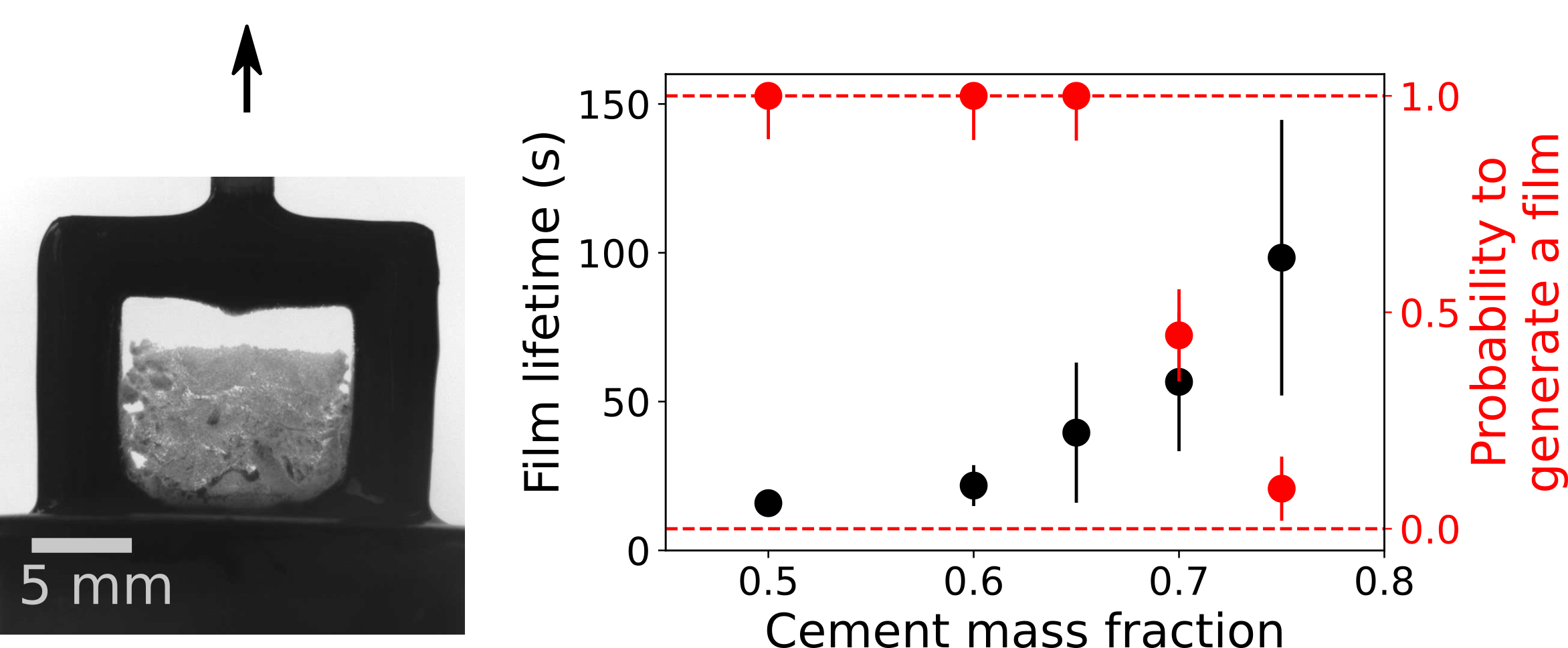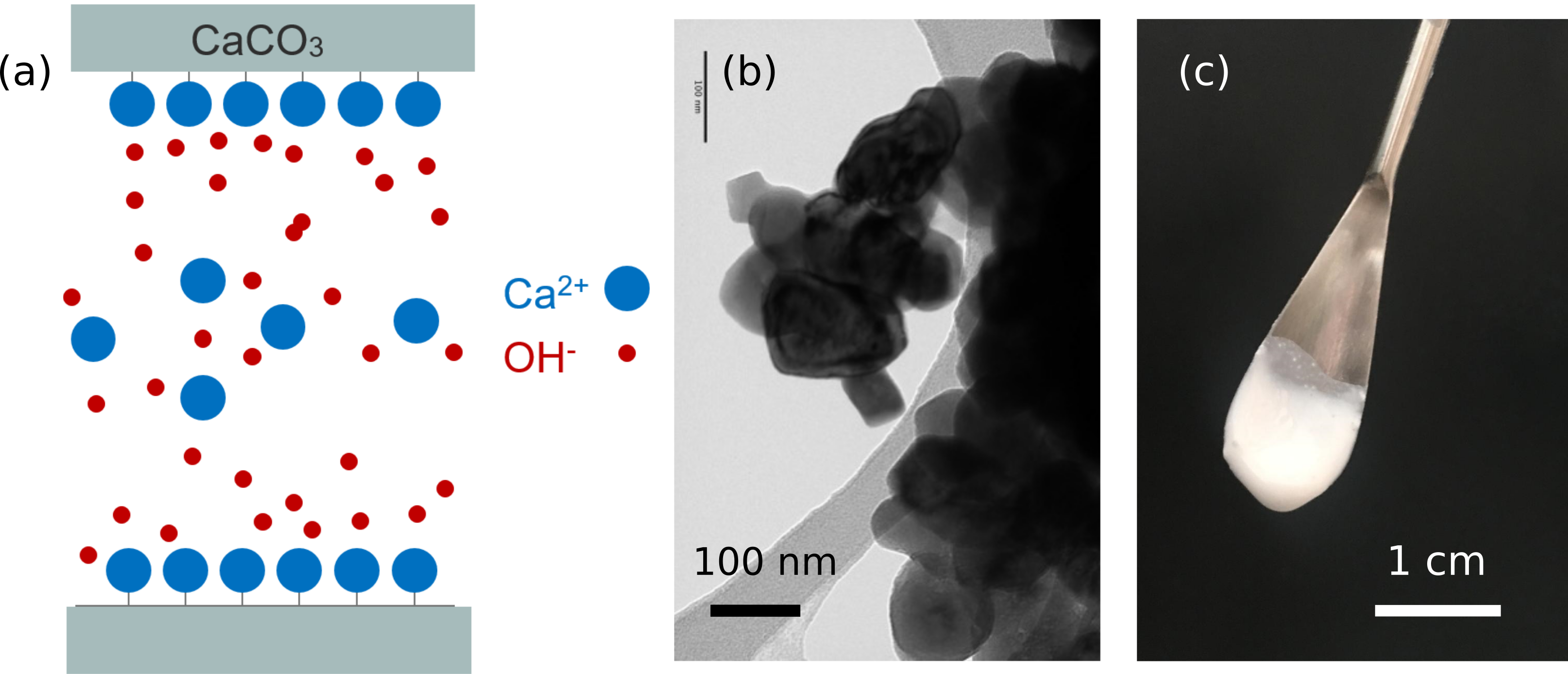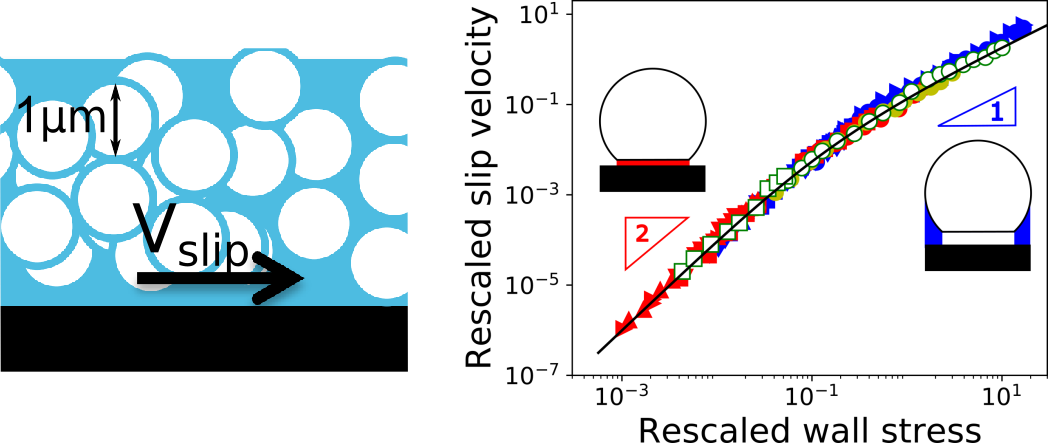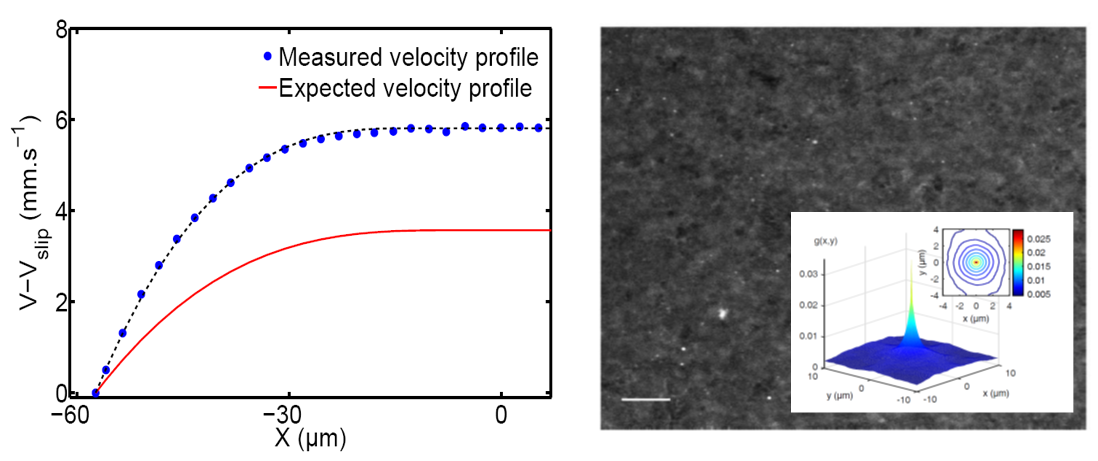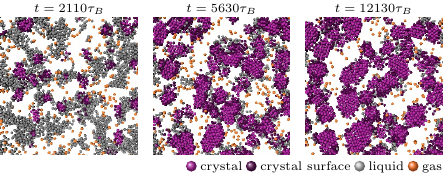Complex fluids |
|
We seek to understand dynamical processes that govern stability and flow of complex fluids, which include amorphous systems, foams, disordered materials, yield stress fluids, etc. The goals that underline many of our experiments is to explain the macroscopic response of these materials from the microscopic structures and dynamics, and to understand the role of surfaces and confinement. |
|
Members: Barentin, Catherine |
|
Highlights |
Spreading of drops made of yield-stress fluidsContrary to what is observed with Newtonian fluid and stated by the Young’s law, the final contact angle reached during the spreading of a drop made of yield stress fluids depends on the drop size, on the fluid rheology and on the hydrodynamic boundary conditions. These results can be rationalized in terms of dynamic arrest due to the existence of a yield stress. Dynamic arrest during the spreading of a yield stress fluid drop, Martouzet et al., Phys. Rev. Fluids (2021). |
|
Spreading of yield-stress fluids drop: side views of drops (left), Final contact angle as a function of the Bingham-capillary number (right) |
Generation and stability of cement soap filmsBy withdrawing a frame from a fresh cement suspension at controlled velocity, we find an optimum solid fraction to achieve both generation and stability of the cement soap films. These films are the elementary units of foamed cement used to elaborate new porous insulating building materials. Generation and stability of cement soap films, Ahmed Abdourahman et al., Soft Matter (2021). |
|
|
How ions control the rheology of calcite gelsSimple ions like calcium or sodium adsorb on mineral surfaces and control interparticle forces between colloids of calcite (calcium carbonate) found in industrial and geological processes. Solution physicochemistry thus provides a control on the elasticity of calcite gels and on flow properties like shear banding. Simple ions control the elasticity of calcite gels via interparticle forces, Liberto et al., J. Colloid Interface Sci. (2019). Interparticle attraction controls flow heterogeneity in calcite gels, Liberto et al., Soft Matter (2020). |
Ions adsorbed on calcite surfaces (a) modify interaction forces between colloids (b) in solutions and the rheology of colloidal gels (c). |
Wall slip of polymer microgels flowsWe use microfluidics channels to measure the slip velocity of jammed suspensions of polymer microgels as the wall stress is increased by 4 orders of magnitude. The friction law exhibits a transition in slip regimes, from a nonlinear to a linear scaling, linked to two distinct dissipation mechanisms at the scale of the soft elements, determined independently through fluorescent microscopy. Wall slip regimes in jammed suspensions of soft microgels, Péméja et al., Phys. Rev. Fluids (2019) |
(Left) The apparent wall slip arises from the motion of polymer soft spheres close to the wall. (Right) The rescaled slip velocity vs the rescaled wall stress exhibits two power law regimes |
Simulations of a topological rearrangement in foamsThe elementary process in the flow of a foam is a T1 event, a topological rearrangement involving the relative motion of bubbles which switch neighbours. Using level-set simulations that describe the interface and surfactant dynamics, we investigate the role of surfactants and find that their presence can change the nature of the flow from purely extensional to a shear. Level-set simulations of a 2D topological rearrangement in a bubble assembly..., Titta et al., J. Fluid Mechanics (2018). |
(Left) The simulation set-up: bubbles are sheared by the motion of top and bottom plates (Right) Bulk surfactant concentration in the foam liquid film. |
Confined flows of microgelsWe study the breakdown of bulk rheology in confined flows of yield stress fluid made of highly entangled polymer microgels of Carbopol. Cooperative processes under flow are evidenced. We additionaly introduce an original optical microscopy method to access structural properties of the microgel. Overall, the combine static and dynamic characterization provides a strong grounding to the “Shear Transformation Zones” modeling approach. Confined flows of a polymer microgel Géraud et al. EPJE (2013) & EPJE (2017) |
Left: Departure between measured and calculated velocities. Right: Gel microstructure studied by fluorescence correlation spectroscopy. |
Colloidal rainWe study experimentally the process of gel formation in colloids, often described as a phase separation arrested by a glass transition. Here we found that the arrest can instead be due to crystallisation. The crystallisation proceeds by the same mechanism responsible for the formation of rain in clouds. Formation of porous crystals via viscoelastic phase separation, Tsurusawa et al., Nature Materials (2017). |
Crystal-gel formation process, computer reconstruction from 3D coordinates obtained by confocal microscopy. Particle diameter is 2.3 µm |
Elasticity and yielding of calcite pasteWe characterize the rheology of suspensions of calcium carbonate to get information on the inter-particle interactions in this model system for cement. We found that the yield strain of the pastes exhibits a minimum versus concentration, a major prediction of colloidal-gel theory, never verified so far. |
(a) Calcite paste. (b) Yield strain vs solid volume concentration with corresponding sketches of the microscopic structure. |
Wrinkling yoghurtWe study the wrinkling of a thin protein gel film (basically yoghurt) between two glass plates. pH-controlled contraction and swelling cause wrinkling. We show that the wavelength of the wrinkles is controlled dynamically either by the viscosity of the whey or by the porosity of the gel, two properties that have been overlooked so far in theoretical explanations of wrinkling. The results could be helpful to understand the physical forces that help shape the embryo. Hierarchical wrinkling in a confined permeable biogel, Leocmach et al., Science Advances (2015). |
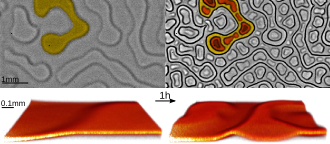 |
More highlights |


















